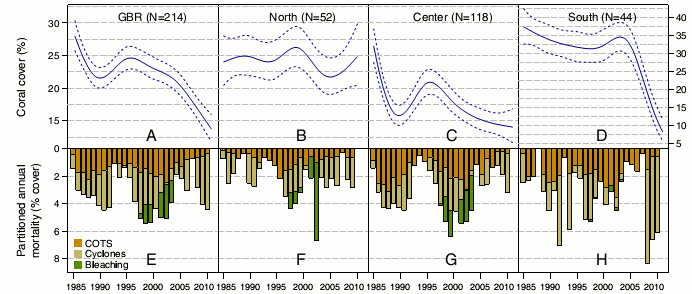
Key Points
Figure 1 - Trends in coral cover, and annual mortality due to Crown-of-Thorns starfish (orange bars), cyclones (olive green), and mass coral bleaching (dark green) for the whole Great Barrier Reef (A&E), northern (B&F), central (C&G) and southern (D&H) GBR regions. From De'ath (2012).
Last Chance to See, was the title of a 1989 BBC radio documentary series and subsequent book. The series featured reknowned author, Douglas Adams, and zoologist Mark Carwadine - both staunch and passionate environmentalists. The 2nd iteration of the series featured Carwadine and the ever-brilliant actor/writer, Stephen Fry. The plot of the series and book involves travelling to extinction hotspots to bring public attention to species on the brink of extinction.
Whilst the Great Barrier Reef on Australia's north-eastern coast may not currently be in a situation as precarious as those species visited by Adams, Carwadine, and Fry, the spectacular rate of die-back of coral on the reef raises genuine concern that it is heading for calamity. The background ocean state is on a path (warming and acidifying) that will make survival incredibly difficult for reef-building coral of the Great Barrier Reef and elsewhere (Meissner [2012], Frieler [2012]), so the next several decades may indeed represent the last chance to see.
On a global scale coral reefs are rapidly disappearing from the world's oceans. Whilst in certain regions local scale effects, such as overfishing, nutrient run-off pollution, and disease are exacerbating this worldwide decline; the globally coherent nature of this dieback (Bruno & Selig [2007]) points to a global-scale phenomenon i.e. global warming. The two prime agents of harm for coral are marine heat waves and ocean acidification.
Marine heat waves, if severe enough, result in the expulsion of symbiotic algae from within the coral's skin tissue. The algae provide food for the coral polyp using the sun's energy (photosynthesis), however, when water temperatures exceed an upper thermal threshold the algae begin to produce too much oxidative waste poisoning the coral (Nesa [2012]). The coral polyp has no choice to but to evict the algae to avoid being poisoned, which results in the characteristic bleaching (whitening) as the algae produce the pigments which give coral their colour. Without the algae, the coral are without their main source of food (filter-feeding is a secondary source of nutrition) and are prone to disease (Mao Jones [2010], Ruiz-Moreno [2012]). Coral often die after intense bleaching events, but even if they do survive bleaching, calcification (growth) can be significantly impaired (Baker [2008], Cooper [2012]).
Ocean acidification is a threat to coral not because of the increase in seawater acidity directly, but due to the fact that ocean acidification reduces the availability of carbonate ions in the oceans, and carbonate ions are, ultimately, one of the key building blocks of the coral's calcium carbonate skeleton (Kleypas [2006]). Under extreme future business-as-usual scenarios the tropical oceans may eventually become physically corrosive to coral (Cao [2007]), but the major concern today is that acidification, through the decline in carbonate ions, is making it energetically more costly for coral to build their skeletons. Most species typically don't have a lot of energy in their energy budget to spare, so extra effort spent building their skeleton can impact other crucial areas of the coral life cycle, such as spawning, which may act to reduce reproductive success.
Another negative implication from recent scientific studies are that while coral continue to expend energy skeleton-building in carbonate ion-depleted sea water states, the crystalline stuctures they build are poorly-formed (Cohen [2009]) and the cementation of the reef substrate upon which they attach becomes physically weaker (Madin [2008] & [2012]). A classic modern-day example of this weak cementation in carbonate ion-depleted (low pH) seawater are the coral reefs of the eastern tropical Pacific (off the central American coast) - a region prone to episodic upwelling of acidified deep seawater (Manzello [2008]). Here coral reef development is patchy and highly susceptible to disruption - as evidenced by the almost complete devatastation of coral reefs at the Galapagos Islands from the 1982-1983 El Niño, when 95% of the coral there were destroyed (Glynn [1990]).
These factors are an enormous handicap for coral which rely on rapid growth rates, and strong skeletons and reef substrate, to overcome bioerosional forces (wave damage and attack by predators). Unless they can sustain this growth advantage over competitors, and against natural forces which break down the integrity of their skeletons, such as coral-eroding sponges (Wisshak [2012]), and reproduce in sufficient numbers, they are likely to succumb to global warming.
De'ath (2012) investigated the trends in coral cover on the Great Barrier Reef in order to estimate, by way of observed and modelled environmental data, the causes of coral mortality. They also assessed the capacity of the reef to recover in the absence of disturbance, and to estimate future living coral cover based upon recent trajectories.
As opposed to previous studies which weaved together data from various survey methods, De'ath (2012) had the distinct advantage of utilising a consistent observational method. This survey method is the manta tow sampling protocol - where a trained observer is towed behind a boat on a manta board, and at pre-determined intervals, stops to record observational estimates of coral cover, Crown-of-Thorns starfish density, fish abundance etc (Bass & Miller [1996]). Although this might seem an imprecise way of sampling, previous qualitative assessments of the technique have shown it to provide accurate and reliable data provided the observers are adequately trained (Miller & Muller [1999]). The attraction of the manta tow technique, aside from its accuracy, is that it is low cost and can cover a lot of territory in the alloted time.
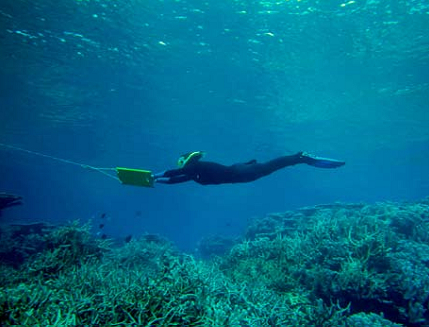
Fig 3 - Example of an observer being towed along the reef edge using the manta tow technique. From Miller (2009).
Blending together the 2,258 manta tow surveys of the 214 reefs, aerial-based estimates of mass coral bleaching, and meteorological wind speed data for the 34 tropical cyclones that occurred during the 27-year period, the authors were able to model the percentage of coral cover on the Great Barrier Reef throughout the interval. They also partitioned annual mortality as a percentage of this cover. This is shown in Figure 1 for the Great Barrier Reef as a whole, and the northern, central and southern regions. See figure 4(A) below for a breakdown of these regions.
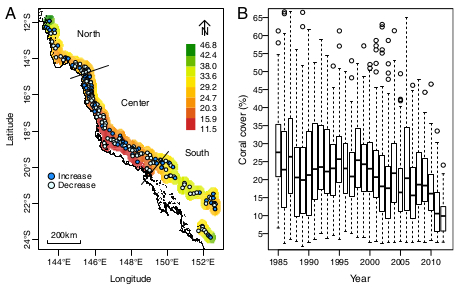
Fig 4 (A) - map of the GBR with the colour-shading representing the direction of the mean coral cover over the 1985-2012 period - see colour key. The small dots show the locations of the 214 reefs surveyed. 4(B) boxplot shows the percentiles (25%, 50%, and 75%) of the coral cover distributions in each year. (A percentile is a value below which a certain number of observations fall in each boxplot (or bar) 25% in the lower segment of the boxplot, 50% the band in the middle, and 75% for the top segment of the boxplot). A substantial decline in living coral is apparent. From De'ath (2012).
As shown in Figure 1, the bulk of the coral dieback has been due to cyclone damage (48%), which has increased over the 27-year period. A great deal of this arises from intense cyclone activity in the southern reef area over the last few years (D & H in Figure 1) . The 2nd most lethal disturbance is a result of Crown-of-Thorns starfish (COTS) outbreaks (42%), which attack and kill coral. This, however, seems to be a periodic phenomenon. There is no clear trend over the interval but, according to the analysis, coral mortality due to COTS has clearly declined in the last 10 years. This is a reef-wide observation.
By comparison, coral dieback resulting from marine heat waves (mass coral bleaching) is much smaller (10% mortality). This is not surprising as the GBR has not experienced any marine heatwaves likely to induce bleaching in the last 7-8 years, and before that has only recently warmed enough to approach the upper thermal tolerance threshold for GBR coral.
Coral have a remarkable capacity for growth, given the right conditions, and this was one hopeful aspect of the study. Despite the overall decline in living coral cover on the reefs surveyed, some reefs were displaying strong increases in the amount of coral cover. The authors estimated that declines in coral cover amounted to 3.38% per year, but that increases in living coral cover amounted to 2.85% per year. This gave a total (net) decline of 0.53% per year. As the authors point out, this demonstrates the potential for a substantial recovery if the causes of coral mortality can be arrested. Obviously there is no short-term fix for cyclone activity, or the likelihood of marine heat waves increasing in frequency and severity.
COTS outbreaks are another matter. They resulted in coral mortality of 1.42% per year between 1985-2012, and the scale of the outbreaks are directly related to human activity - especially the excess nutrient pollution arising from agricultural fertiliser run-off. The excess nutrients provide ideal breeding conditions (abundant food in the form of phytoplankton blooms) for COTS larvae, and are thought responsible for the greater-than-normal population explosions of this coral-destroying starfish (Fabricius [2010]). If nutrient run-off can somehow be reduced sufficiently there is the possibility of turning the net coral cover decline into an increase (Webster [2012]).
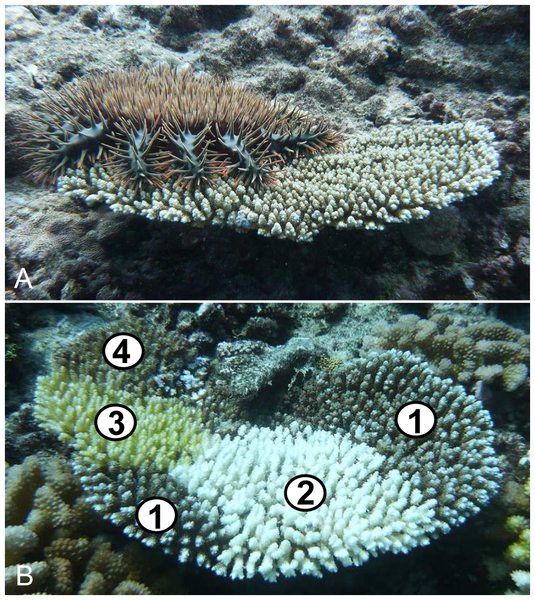
Figure 5 - a) Example of a Crown-of-Thorns starfish (COTS) on a living coral. b) shows the damage inflicted by a COTS attack. The numbers denote 1=live portion with normal pigmentation, 2=freshly killed portion (bleached), 3=recently killed portion beginning to be colonized by algae and bacteria, 4=long dead portion of the coral covered with turf algae. From Kayal (2012).
A key issue boils down to how realistic it is that sufficient measures will be taken to curtail nutrient run-off, to what degree this might diminish COTS outbreaks, and whether this can even be achieved in practice. The central region of the GBR happens to be an area of intense agricultural activity and cattle grazing, with a coastline subject to more and more residential development. It also seems to be ground-zero for the COTS outbreaks, with waves proliferating out from this region.
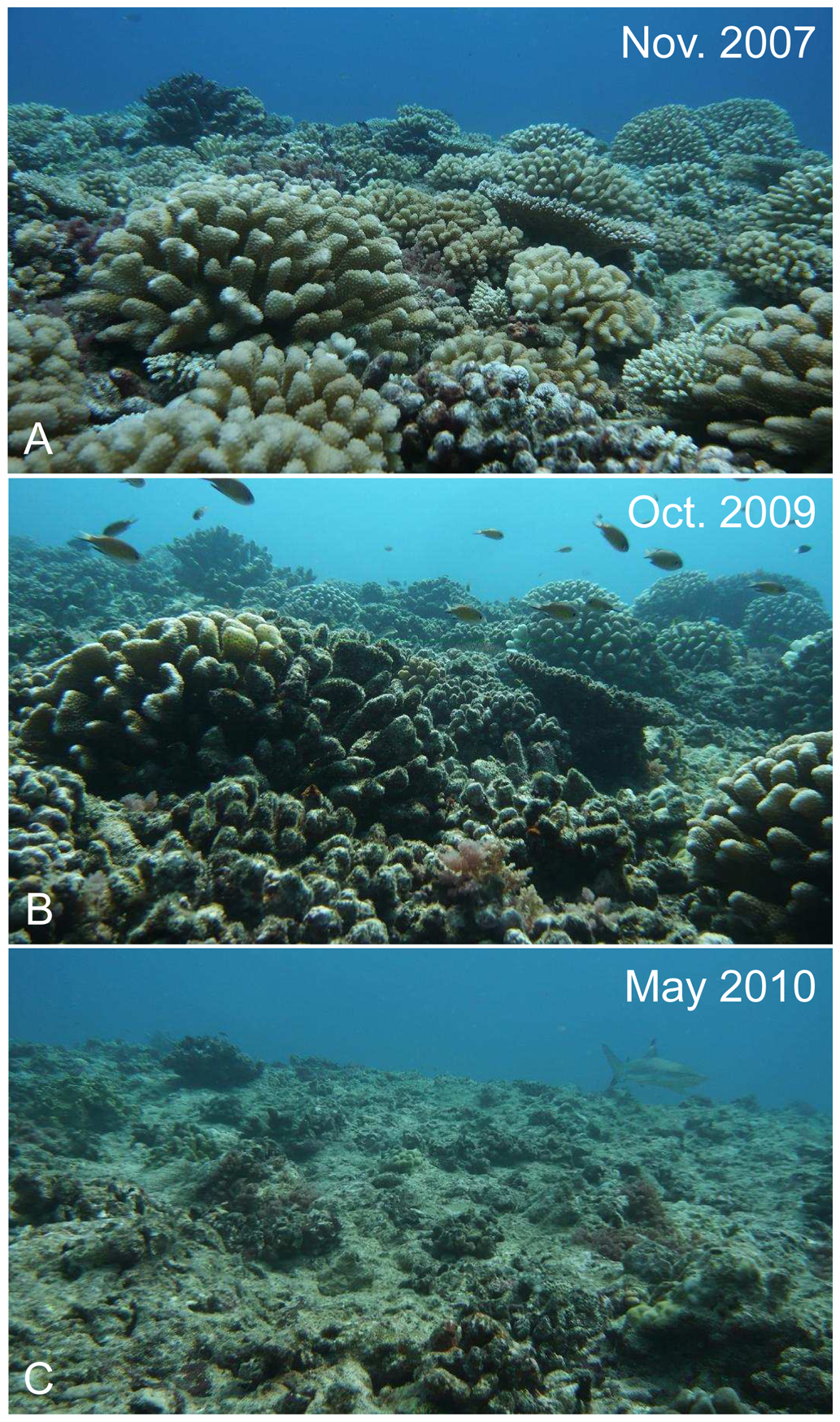
Figure 6 - Example of a French Polynesian reef devastated by a COTS outbreak. A) Healthy reef with cover cover in excess of 40%. B) Algae have colonized the reef after attack by COTS C) Weakened or dead coral are swept away by a cyclone leaving less than 5% living coral cover. From Kayal (2012).
Heavy doses of manufactured fertiliser are a prequisite of modern-day agricultural and farming practices in order to increase yields, so it's going to be difficult to convince growers to shift away from this to prevent further outbreaks. This seems to be borne out by the observations. Despite a reef water quality protection plan being put in place in 2003, 4 years ago another COTS outbreak began off Cairns. It will take place over the coming years, but this latest wave of COTS is likely to grow and spread out, devastating the GBR once again. These coral-killing starfish have perhaps been dealt an additional winning hand due to the intense flooding in Queensland over the past 2 years. This flooding would have flushed greater nutrient loads into the ocean and increased phytoplankton concentrations which Crown-of-Thorns starfish larvae thrive upon (see Fabricius [2010] again). Time will tell.
For its part, the Australian Government appears to not be genuinely concerned about the ultimate fate of the Great Barrier Reef. Simultaneously, it has expressed an intention to save the reef, whilst planning to greatly increase fossil fuel exports from sea ports adjacent to the GBR. These are two mutually exclusive proposals. It's like vowing to stop being a couch potato while shopping for a huge new television.
As well as further fossil fuel combustion adding to the ocean warming and acidification trends, and possibly intensified cyclones (Emanuel [2012]), the planned wholescale dredging of the harbours to facilitate larger ships entering the ports, will increase sedimentation. This is yet another deleterious effect on GBR coral close to the dredging, as it smothers them, reduces water clarity (and hence photosynthetic efficiency) and lowers their tolerance to bleaching (Anthony [2007], Flores [2012], Erftemeijer [2012], Golbuu [2010]).
The future does not augur well for the GBR. Considerable forces, many of them driven by human activity, are aligning themselves against the future viability of the reef. Mass coral bleaching is virtually guaranteed to return and intensify, as the global oceans continue to warm. The future trend of cyclone intensity is still being debated in the scientfic community, but if cyclones to continue to grow ever more severe, as the recent Queensland trends and some research suggests, then this introduces another significant threat. Then, of course, there is ocean acidification.
A brief glimmer of hope rests on the spectacular growth rate of coral, and the possibility of reducing future Crown-of-Thorns starfish outbreaks. This is unlikely to happen anytime soon, as a recent wave of COTS is currently spreading out across the coral reef. The GBR is going to need more than just a little bit of luck, and the next several decades may be your last chance to see...
Posted by Rob Painting on Tuesday, 29 January, 2013
 |
The Skeptical Science website by Skeptical Science is licensed under a Creative Commons Attribution 3.0 Unported License. |